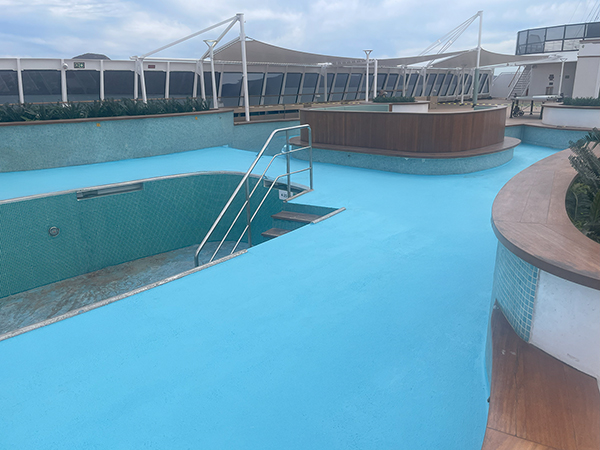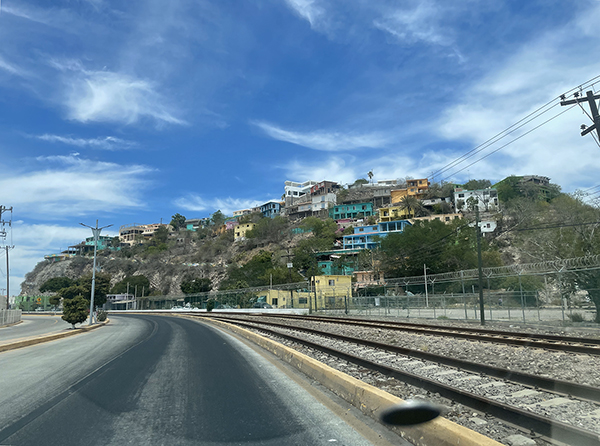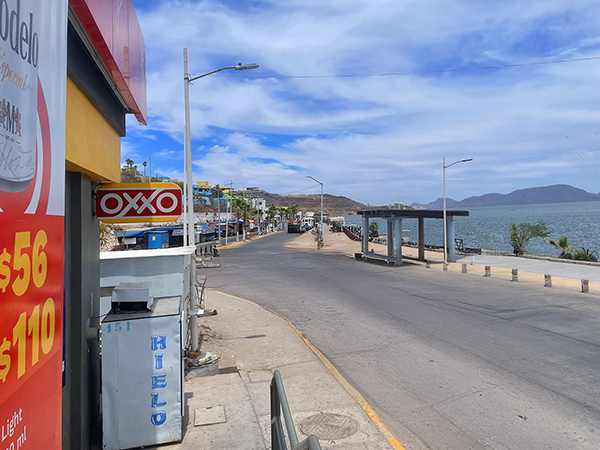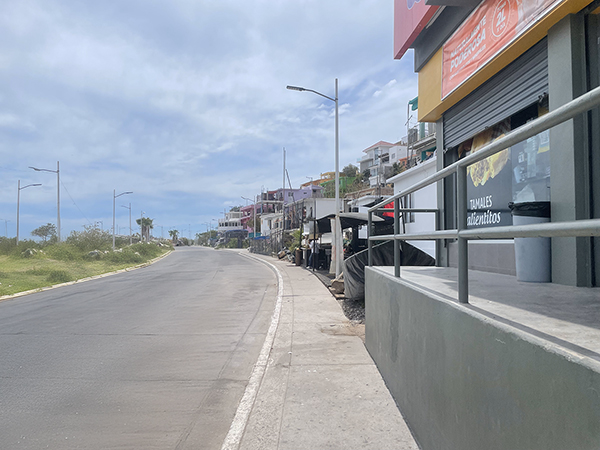|
May 18-20, 2025
Marti Eicholz
After a beautiful Sunday sail, The Odyssey docks in Topolobampo, Mexico, a
charming destination that combines a unique blend of Mexican and Indigenous
cultures with stunning natural landscapes like towering mountains to the
crystal-clear waters.
Topolobampo is a place where the magic of the elements, the wild land of
hills, cactus and pitahayas combines with the blue sky in the day and stars
in the night, becoming a universal symphony.
Topolobampo and Los Mochis, 15.5 miles from each other, are in the
north-western region of the state of Sinaloa. Topolobampo is a commercial
industrial port town on the coast of the Gulf of California, known as the
Sea of Cortez and serves as a gateway to states in northwestern Mexico via
the Chihuahua-Pacific Railway.
Topolobampo and Los Mochis sit at sea level with a semi-arid climate. Being
here in May, we avoid the extreme temperatures and heavier rains of July and
August.
In 1893, a civil engineer specializing in railways, Albert Kimsey Owen,
landed with a group of dreamers in pursuit of a dream, joining the Atlantic
and Pacific by a railway system to build an important commercial canal
between East and West.
The vision of Albert Kimsey Owen, after sleeping under the stars of
Topolobampo, Albert Kimsey Owen describes visualizing with marvel at the
spell of the earth:
“Leaving my blankets I walked among the mountains, arriving at the edge of
the beach. What a panorama! A whole enclosed sea! I said to myself: If in
the morning I find a deep and secure entrance channel from the Gulf of
California, here on this bay, it will be the site of a great metropolitan
city. On the sea, a sail is not found today, ships from all nations will
sail and families on these plains will live happily. The Australian will
meet the European, who will come by rail across the continent from the
Atlantic.”
Albert Kimsey Owen believed that Topolobampo, already serving as a port,
could function as a railway terminal due to its location and topographical
characteristics. Owen envisioned the construction of a transcontinental
railroad, originating from the beaches of Sinaloa, through the mountains,
and reaching the coast of Virginia in the United States. This would be an
extension of Mexico into the great North American railway network. The
project would be accompanied by an experiment in social, urban,
philosophical, and political order, the foundation of a utopian socialist
system, reforming the corrupt capitalist system. Owen outlined a parallel
project: the construction of the railroad and the creation of a just,
modern, and peaceful city, proclaiming it as “cooperation is harmony.” So,
he and his followers founded Topolobampo as a utopian socialist community.
The dream of Owen’s utopian socialists coming from the United States of
America is now realized. From its docks ferries depart that connect the
north of Sinaloa with La Paz, B.C. And huge cargo ships that sail the seas
of the world with different destinations.
Another American businessman, Benjamin F. Johnston, attracted by Owen’s
visions, found himself in Los Mochis, visualizing potential in the region,
but in sugarcane cultivation. Johnston built a sugar mill in Los Mochis and
the city grew, becoming the largest sugarcane empire on the American
continent and a top mango producer in Mexico.
Jardín Botánico Benjamin Francis Johnston, Botanical Gardens, designed by
the same architect that built the movie sets and landscapes for Gone with
the Wind, offers a peaceful place to sit and admire local and exotic flora,
local animals, and it includes a butterfly pavilion.
Topolobampo, meaning “place of the poppies,” has a rich history and its
cultural influences come from both the Indigenous Yaqui people and the
Spanish colonizers. To understand more of the town’s history, visit the
Museo de Topolobampo, which houses a collection of artifacts and exhibits,
telling the story of the town’s past.
The most notable landmark, Faro de Topolobampo, a lighthouse, dates to the
1900s. Climb to the top for a panoramic view of the area.
Museo Regional del Valle del Fuerte is where you can learn about the
Sinaloan region and its history and how Los Mochis got its start as a city.
Topolobampo is a small fishing port town where you enjoy cultural,
archaeological and natural spaces, where the Malecón, a boardwalk and
lookout point, is filled with locals and their fishing rods, and little
stalls and restaurants serving fresh catches like shrimp, ceviche, and fish
tacos.
To get a good look at the great biological diversity of its unique natural
landscapes, multiple species of flora and fauna, different seabird species,
and dolphins, take a boat tour around Topolobampo Bay, a sanctuary of
dolphins, birds, mangroves, dunes, sea lions, and lots of semi-desert
vegetation. You may see Pechocho. El Pechocho is a wild dolphin that hangs
out near the fishing port. He is not captive, but local fishermen feed him,
so he sticks around. My friend, Peter, and others found Pechocho, the hermit
dolphin, living alone in a secluded lagoon for the past forty-two years. He
came close. They petted him and everyone, including Pechocho was happy.
Maviri Beach, seven miles from Topolobampo and situated on the Sea of
Cortez, is a large, sandy beach with its own little boardwalk, lookout
point, and seafood eating places.
Topolobampo is known for long beautiful pristine soft sandy beaches (Playa
Las Glorias, the most popular) of immense dunes and calm crystal-clear azure
waters, ideal for surfing, kayaking, diving, fishing, skimboarding, sailing,
or taking a boat ride through the waters of the Sea of Cortez accompanied by
friendly dolphins.
The Sea of Cortez, known as the Gulf of California, is a biologically rich
body of water, recognized for its biodiversity and home to an incredible
array of marine life: over nine hundred species of fish, thirty-two species
of marine mammals, and five species of sea turtles. A haven for wildlife
enthusiasts and marine biologists.
Topolobampo is known for its natural landscapes. Visit some of its natural
wonders like the Cave of Bats, a significant natural sanctuary for thousands
of bats from April to October. A unique spectacle to witness bats emerging
at dusk, creating a “black cloud” in the sky. These bats play a crucial role
of ecological importance in the ecosystem, like pest control, forest
regeneration, plant pollination, and controlling rodent and reptile
populations.
Explore the rocky little island of San Ignacio Farallon, the world’s largest
marine rocky outcrop, nine miles off the coast of Topolobampo and enjoy the
semi-desert vegetation of the bay. Sea lions can be seen lounging on the
rocks between October and April.
Another little island to visit is the Isla de las Aves, referred to as the
Island of the Birds. This is home to many species of local and migratory
birds.
The Odyssey sails toward La Paz, Mexico.
|





